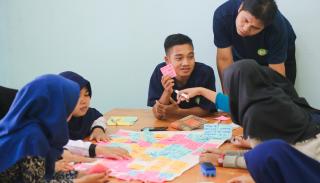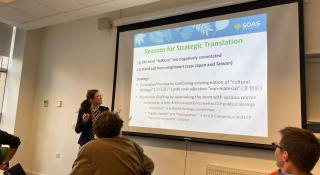
Breadcrumbs navigation
Strategies and practices for teaching International Studies
Cornelia-Adriana Baciu - awarded the BISA Prize for Excellence in Teaching International Studies by a Postgraduate in 2019 – discusses the evaluation and teaching strategies she used, the approaches she applied to stimulate critical thinking, how she addressed the needs of a diverse population and the sharing of teaching practices with colleagues and the international community.
“Science is responsible for the progress of the society” claimed the German journalist Carl von Ossietzky, laureate of the Nobel Peace Prize in 1935; and teaching can be responsible for the production of knowledge and science, I would add. In a rapidly changing international environment in the 21st century, teaching and academic research can have a stabilising impact on societies by enabling the creation of a body of knowledge and scientific outputs which can help us to understand, explain or predict crises or instability. But how can teaching at postgraduate level be positively intertwined with completing the PhD dissertation and writing journal articles and/or books?
During my PhD at Dublin City University I gained extensive teaching and evaluative experience in course design and syllabi formulation in International Security, Theories of International Relations, Research Methods and Comparative European Politics. In 2019, I lectured several sessions on Theories of International Relations (part of the module Military History and Strategic Studies) to the 32. Junior Command and Staff of the Irish Defence Forces at Maynooth University, Ireland. In addition, I was grading assistant for the BA lectures International Relations and Security and Comparative European Politics. The most comprehensive teaching experience I gained while being a semester-long lecturer and module coordinator for the course Introduction to Research Methods and Skills for the BA programme in’ Economics, Politics and Law’ at Dublin City University, which encompassed 146 Irish and international students and four tutorial groups, which were also under my coordination and supervision.
In this blog I present the evaluation and teaching strategies which I used, the approaches I applied to stimulate critical thinking, how I addressed the needs of a diverse population and the sharing of teaching practices with colleagues and the international community.
Use of Innovative Evaluation and Teaching Strategies
Continuous Assessment as Evaluation Method.
For the courses which I taught I designed evaluation strategies which would develop students’ key competences in international dissemination of their future research and the generation of innovative outputs which inform the policy community and benefit the society. The course evaluation was distributed along several smaller and diverse assignments (continuous evaluation), instead of putting the weight on a major assignments (e.g. final exam). For example, for the course in research methods, the evaluation consisted of six different tasks, inter alia tutorial assignments and exercises, a group presentation and an essay. The group work stimulated students to develop techniques to negotiate in team situations, effectively communicate their analysis to peers and take collective responsibility. Through the essay assignments, students learned how to plan, draft and reference appropriately and develop annotated bibliography. Some of the students were encouraged to turn their essays in a blog submission. Overall, the continuous assessments constituted an innovative evaluation method, which was substantively beneficial for the development of students’ core competences and abilities in producing impactful research outputs.
Online Teaching Materials.
To enable students’ access to the reading materials for this course, all compulsory reading texts were scanned and made available on DCU’s internal system ‘Loop’ before the commencing of the semester. This was particularly helpful, as the number of the enrolled students for the lectures I thought ranged between 25 and 146, with high competition on materials available in the Library’s paperback resources. In addition, teaching materials such as the class presentations and hand-outs were uploaded on ‘Loop’ after each session, to enable access to part-time students or students who, e.g. due to attenuating circumstances, were not present during a particular sessions.
Use of Multimedia Materials to Enhance Innovation and Policy-Relevance.
To encourage students to contribute to the development of innovative and policy-relevant scholarship and to develop a more coherent approach and greater understanding of the impact of the particular issue thought, multimedia resources were employed during the lectures, when relevant. The use of multimedia and educational technology in classrooms can complement traditional teaching methods and has scientifically proven advantages for improving students’ critical thinking and core skills. Visual multimedia can be helpful for students to make conceptual distinctions, to make links between different disciplines in their curricula and to apply knowledge to answer real-world questions.
Stimulating Independent Learning and Critical Thinking
Class Discussions, Simulations and Counterfactual Reasoning.
To increase class participation and interactivity and enhance independent learning and critical thinking, class discussions were held at the beginning of each session. Students were instructed to get informed about key developments in international relations via different media and be prepared to discuss them in class. Circa 5 minutes discussions took place at the beginning of each session, which constituted a good warm-up and enabled students to debate important topics of international relevance. The students were asked to counterfactually think about future scenarios in the aftermath of specific developments, propose solutions to a current crisis or problem in international politics and link the developments with the concepts learned in class.
Reading Forms Highlighting Key Elements of a Research Design.
To enhance the students’ ability to conceptualise clear, coherent and logical arguments, but also to stimulate them to engage with the reading material, they were asked to fill-in reading forms for each lecture session, identifying the research questions, methodology, data sources and findings of one article from the reading list. The forms were discussed briefly in class.
In-Class Experiments were conducted in circumstances in which difficult concepts had to be explained to the students. For example, to increase students’ understanding of the Prisoners’ Dilemma and the evolution of cooperation (Axelrod 1984) between states, the following experiment was conducted: students were presented with an incentive of €20; if they agreed to cooperate it would have been distributed equally among the group; if one of them defected, he/she would keep all money; then they were asked to take out a piece of paper and write 'C' to cooperate and 'D' to defect. Usually, circa 25% of the participants defected, but cooperation was achieved when the experiment was repeated.
Meeting the Needs of the Diverse Student Population
‘Brainstorm’ Initiatives.
Students enrolled in the lectures which I though usually had different social, demographic and cultural backgrounds. To meet the needs of the diverse student population, I conducted regular ‘Brainstorm’ activities asking open-end questions. Students were encouraged to write down questions and ideas related to the asked questions. The Brainstorm initiative provided a platform for students to participate and also fostered in-class networking and connection by increasing participation and social cohesion among the student community. Students’ spontaneous answers gave me an idea about the way they are thinking. By considering and incorporating these specific insights into the course curricula (e.g. in the examples which I used), the course content became more representative of the diverse student population and more engaging and appealing to them.
After-Class Consultations.
To encourage students to let me know about their peculiarities and genuine challenges, at the end of each lecture, I invited them to talk to me about course-related issues or any difficulties they might encounter, directly after class or by making an appointment. Knowing more about students’ experiences allowed me to consider the specific matters when scheduling presentations or offer them bespoken deadline extensions.
Sharing of Good Teaching Practice With Colleagues and International Community
Archiving Power-Point Presentations and Handouts.
To share good teaching practice with colleagues, both at Dublin City University and Maynooth University, the files of the power-point or Prezi presentations as well as the handouts and other additional materials for each session were archived in the online Loop/Moodle system and shared with colleagues who thought the courses in the upcoming semesters.
Inviting Colleagues to Sit In and Peer Review. To enable exchange of teaching practices and methods, I pro-actively approached the topic of teaching during informal discussions with colleagues and invited them (usually a PhD student in final year) to sit in during one session of the lecture delivery. After the lecture, I asked them to provide feedback, which was very beneficial for improving my teaching.
Use Online Platforms such as Prezi.
The benefit of online platforms such as Prezi in preparing the class presentations is that the material can be accessed from any computer (connected to internet) and it offers unique presentation designs. Via Prezi, I made the class presentations and materials publicly available and thus ready to be accessed by my colleagues and the international academic community.
Author
Cornelia-Adriana Baciu is a final year PhD candidate in Politics and International Relations and Government of Ireland Fellow at Dublin City University. She was awarded the BISA prize for Excellence in Teaching International Studies by a Postgraduate. Cornelia’s research focuses on international peace, European security, civil-military relations, strategy, institutional change in fragile states and research methods. She is the founding director of the transnational research network “European Security and Strategy”. In 2019, her co-edited book 'Peace, Security and Defence Cooperation in Post-Brexit Europe. Risks and Opportunities' was published.
Photo by Zainul Yasni on Unsplash


